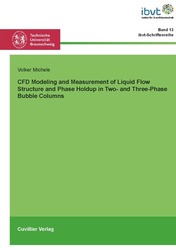| Departments | |
|---|---|
| Book Series (96) |
1378
|
| Nachhaltigkeit |
3
|
| Gesundheitswesen |
1
|
| Humanities |
2364
|
| Natural Sciences |
5406
|
| Mathematics | 229 |
| Informatics | 319 |
| Physics | 980 |
| Chemistry | 1363 |
| Geosciences | 131 |
| Human medicine | 243 |
| Stomatology | 10 |
| Veterinary medicine | 108 |
| Pharmacy | 147 |
| Biology | 835 |
| Biochemistry, molecular biology, gene technology | 121 |
| Biophysics | 25 |
| Domestic and nutritional science | 45 |
| Agricultural science | 1004 |
| Forest science | 201 |
| Horticultural science | 20 |
| Environmental research, ecology and landscape conservation | 148 |
| Engineering |
1793
|
| Common |
98
|
|
Leitlinien Unfallchirurgie
5. Auflage bestellen |
|
Advanced Search
CFD Modeling and Measurement of Liquid Flow Structure and Phase Holdup in Two- and Three-Phase Bubble Columns (Volume 13) (English shop)
Rainer Krull (Editor)Volker Michele (Author)
Preview
Extract, PDF (110 KB)
Table of Contents, PDF (37 KB)
Multiphase flows are of fundamental importance in many reactor concepts in today’s chemical and bioprocess industry.
Over the last years, increasing volumes of products manufactured in fermentation processes or using heterogeneous catalysis have yielded a need for large-scale reactors, in turn inducing new demand for precise scale-up rules for the transfer of processes from lab-scale to full industrial scale which in the case of bubble columns can mean diameters of several meters. Design of gas-liquid bubble columns has so far mainly been carried out by means of empirical and semi-empirical correlations which have been gained from experimental data e. g. of mass transfer for bubble columns of different scales. While a strong experimental foundation of such correlations provides security for the applications that they initially were conceived for, transferability to other situations is usually very limited.
Thus, in many cases trial-and-error schemes or time-consuming scale-up experiments are necessary to achieve satisfactory performance of the large-scale reactor system. Three-phase flow in bubble columns introduces additional challenges for design and scale-up. Now, not only gas-liquid mass transfer is of concern but additionally, solid fluidization and liquidsolid heat and mass exchange enter the picture yielding a complex interaction of turbulent flow fields, mass transfer and chemical or biochemical reaction inside the reactor. Even modern approaches to reactor scale-up mostly do only consider single aspects out of this multitude, i. e. are restricted to fluiddynamic facets, mass transfer issues or reaction topics. Complete reactor models are still out of reach mostly due to numerical problems in solving the resulting equation systems and – the accelerating development in this field notwithstanding – due to a lack in computational power.
| ISBN-13 (Hard Copy) | 9783689529956 |
| ISBN-13 (eBook) | 9783689529963 |
| Final Book Format | A5 |
| Language | English |
| Page Number | 102 |
| Edition | 2. |
| Book Series | Schriftenreihe des Institutes für Bioverfahrenstechnik der Technischen Universität Braunschweig |
| Volume | 13 |
| Publication Place | Göttingen |
| Place of Dissertation | Braunschweig |
| Publication Date | 2024-10-09 |
| General Categorization | Dissertation |
| Departments |
Microbiology and biotechnology
Engineering |
| Keywords | Empirical and Semi-Empirical Models for Bubble Columns, Empirische und semiempirische Modelle für Blasensäulen, Numerische Strömungsmechanik, Computational Fluid Dynamics, dispergierte Phasen, dispersed phases, Elektrodiffusionsmessverfahren, electrodiffusion measurement technique, Axialgeschwindigkeiten, axial velocities, Integrale Gasrückhaltung, integral gas holdup |








